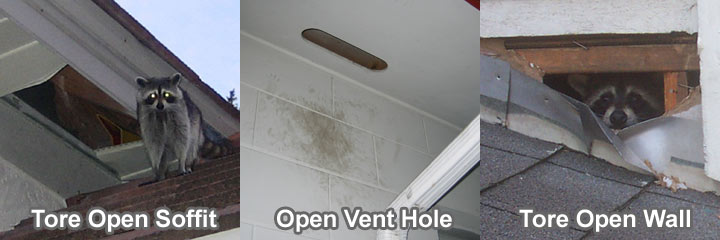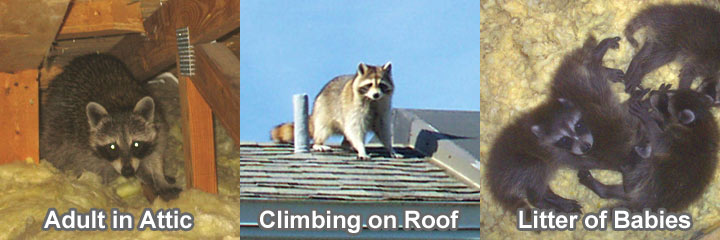Raccoons are not really wild animals. They are urban animals.
Raccoons are FAR more common in cities and suburbs than they are
in undeveloped natural areas. Just like rats. Thus,
raccoon-human encounters are very common. Raccoons are smart,
curious, and agile, and they need a place to live, so they very
often break into a house.
NEED LOCAL HELP? We have
wildlife removal professionals servicing 95% of the USA. Click
here to hire a
local raccoon removal expert in your home town. Updated
2018. But read the below advice first!
Raccoons can live in and cause problems in many areas of the
house. I'll start with the bottom up.
Raccoons in the Basement of the House: This is not
terribly common, but it can happen. Like any part of a house, a
basement is a decent place to live, because it's enclosed and
protected from the elements. Even if the basement is cold and
damp, it's likely warmer and dryer than the outside, especially
at night. And of course, mother raccoons want a safe place to
raise their young. You can actually set traps in the basement,
but you'll have better luck trapping outside, near the entry
hole. Read more about the basement.
Raccoons in the Crawl Space of a House: I've seen
raccoons living in the crawlspace under a house many times. If a
home is elevated, with a crawl space underneath, and there's an
easy opening, it's an open invitation for raccoons, cats,
opossums, and other animals to live under there, just like under
a deck or shed. The key, as usual, is to find the opening(s) and
seal them shut, either when the animal is out, or when it's been
trapped or removed. Read more about the crawl
space.
Raccoons in the Living Space of a House: If you are
unfortunate enough to have a raccoon in your home, inside the
living space, such as the kitchen or living room, be careful.
Raccoons aren't necessarily aggressive, but they are relatively
fearless, and they will defend themselves if necessary. It's not
common for a raccoon to get in the house, but it does happen.
I've even heard of cases of a raccoon in the bedroom. The four
most common ways are: 1) Through an open pet door - to prevent
this, don't leave tempting pet food out all the time. 2) Through
an open fireplace and chimney damper, if they entered the
chimney. 3) Falling or chewing through the ceiling or wall, if
they were living in the attic or walls. 4) Simply through an
open door or window. If a raccoon does get in your home, leave
it alone! Any attempt to fight it might result in injury! Keep
your pets away! Open every window and door that you can find,
and let the animal find its own way out. Or call a pro off of my
list, and he will be able to come get it safely, with a snare
pole.

In terms of entry areas, some people want to know Do
Raccoon Open Doors and Windows, and while they can, they
more frequently enter buildings via roof or soffit areas, or
vents. They want to get into the attic, not the living space.
Raccoons in the Walls of the House: Fairly common,
especially if the mother wants a safe place to stash young. They
usually enter from the attic space, and crawl down the wall.
Read more about the wall.
Raccoons in the Ceiling of the House: Unless it's the
ceiling between floors, you're just hearing raccoons walking in
the attic, on the ceiling material (sheetrock). Read more about
the ceiling.
Raccoons in the Attic of the House: The home page of
this site has all the information you could ever want to know
regarding the safe and effective removal of raccoons from the
attic of your home. They can get into the attic many different
ways. One common way is raccoons climbing the downspout. This is
a very easy way, like climbing a tree, for a raccoon to get onto
the roof and the vulnerable areas into the attic. Read more
about the attic.
Raccoons in the Roof of the House: In my experience, if
a raccoon is on the roof, it's either looking for a way to get
into the attic, or it already has one. But in some cases, these
animals are just exploring for food, or they have found some
little nook, like an eave, to sleep under. I even found one roof
that was so covered in debris - old sticks and leaves and such -
that raccoons were nesting in it. Read more about the roof.
Raccoons in the Chimney of the House: A chimney is a
fine place for a coon to live; it's like a big old hollow tree.
It's usually easier to get them out of a chimney than other
areas of the house, but now always, depending on the
architecture of your home. Be sure to leave your damper shut, or
else the raccoon(s) could crawl out, and into your living room!
Read more about the chimney.

What to do if you have a raccoon in your house - There are two
kinds of raccoons in a house: the ones that are in there on
accident and the ones that want to make your home their home. If
you have a raccoon that wandered in through the pet door or an
open window, your best tactic is to open your door and then herd
the animal outside. Most raccoons will be just as scared to be
inside your home as you are to have them in there. Shooing the
critter out with a broom probably won’t be too difficult. If,
for some reason, the raccoon decides to hide in your bathroom,
lodged behind your toilet, you should call a wildlife removal
company to come and get it. You should never risk tangling with
a raccoon. If it isn’t easily coaxed to the door, don’t try to
harass it or antagonize it. The raccoon that is living in your
attic is a different matter. This raccoon needs to be trapped
and removed, and the home needs to be repaired. Most states
require raccoon trapping to be done by a professional with a
special license. Employing an expert will also ensure no babies
are left behind somewhere in the building.
Read more articles about raccoons:
Will
Repellents Get a Raccoon Out of the Attic?
Do Mothballs or Ammonia Help
Repel Raccoons?
Home Remedies to
Keep Away Raccoons and Get Rid of Them
Will a High-Pitch Sound
Deterrent Machine Work?
...........
Actual Situation: Last night it seemed as if someone was
moving around in my attic...quite scary...just in time for
holloween. In any event I went out on my deck in the dark to see
if some animal was walking on the roof when from behind me
something swished by ..an animal...and headed towards the
stairway. The stream of light from my next door neighbor showed
me that it was a RACOON. It stopped...looked and me...and
scurried across the lawn and away into the backyard bushes. This
morning I went up into the attic but I didn't see anything. What
do I do to keep this racoon away from my attic if he or she
hasn't moved in already. It was as big as a dog and quite
frightening in the dark. Please let me know........Thank
you........Sincerely, Peggy
My response: Do a full inspection of your home,
especially the roof and vents and eave areas, and see if there
are any openings that a raccoon could crawl through. Though they
look large, raccoons can fit through deceptively small spaces.
If there are openings, you might already have raccoons inside,
and you must remove them. If not, secure everything before one
gets inside. Actual Situation: If trees are cut back
and if raccoons can climb the walls and downspouts anyway, is
there anything at all that will deter them from climbing up the
downspouts or climbing walls onto my roof and making holes? -
Vivian
My response: It's pretty hard - they are very good
climbers, and downspouts are no problem.
If trees are cut back and if raccoons can climb the walls and
downspouts anyway, is there anything at all that will deter them
from climbing up the downspouts or climbing walls onto my roof
and making holes? Vivian Article topics include:
How to get rid of raccoons in the house and home.
Get raccoons out of the house and keep them out.
How to remove raccoons from inside the house.